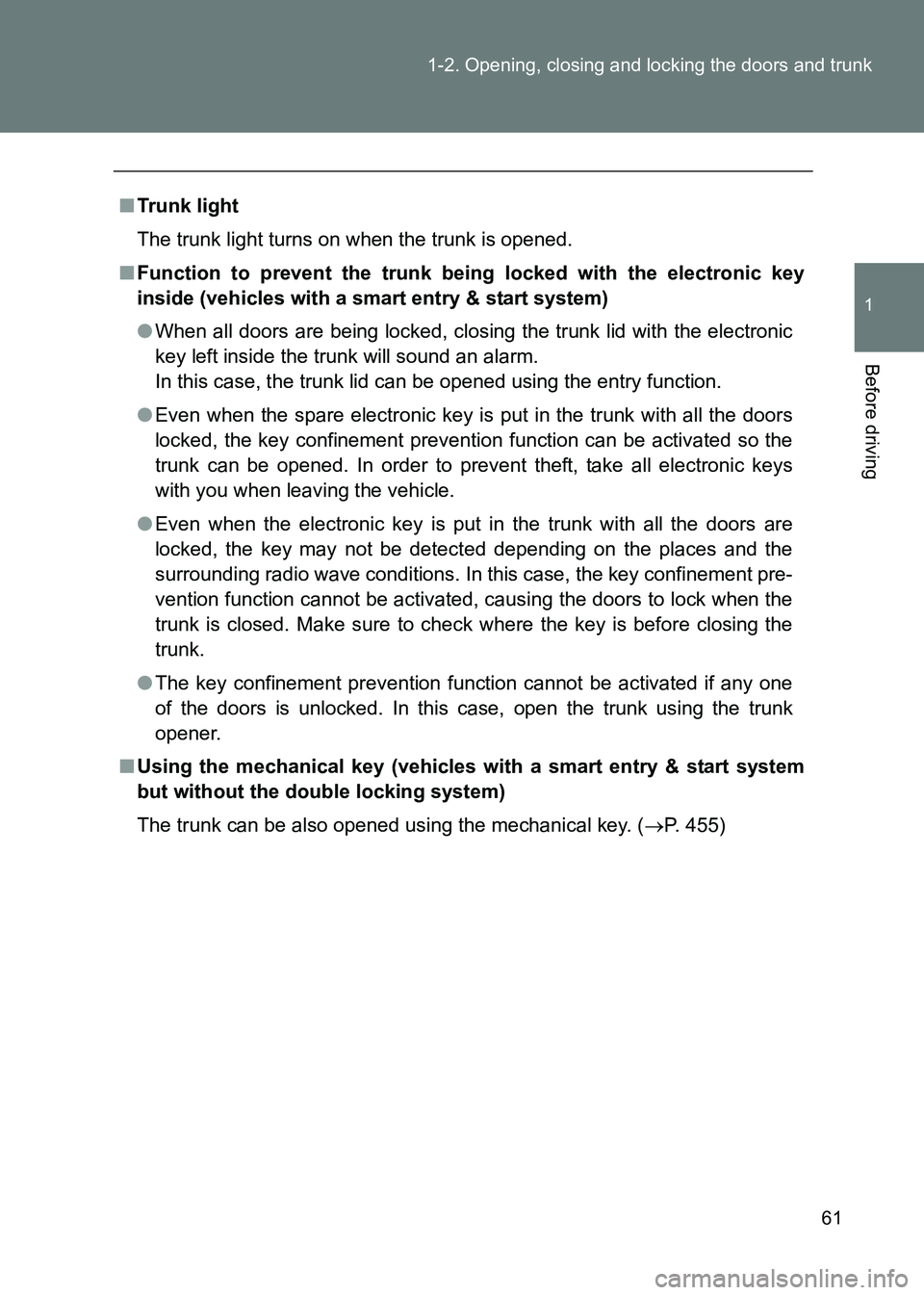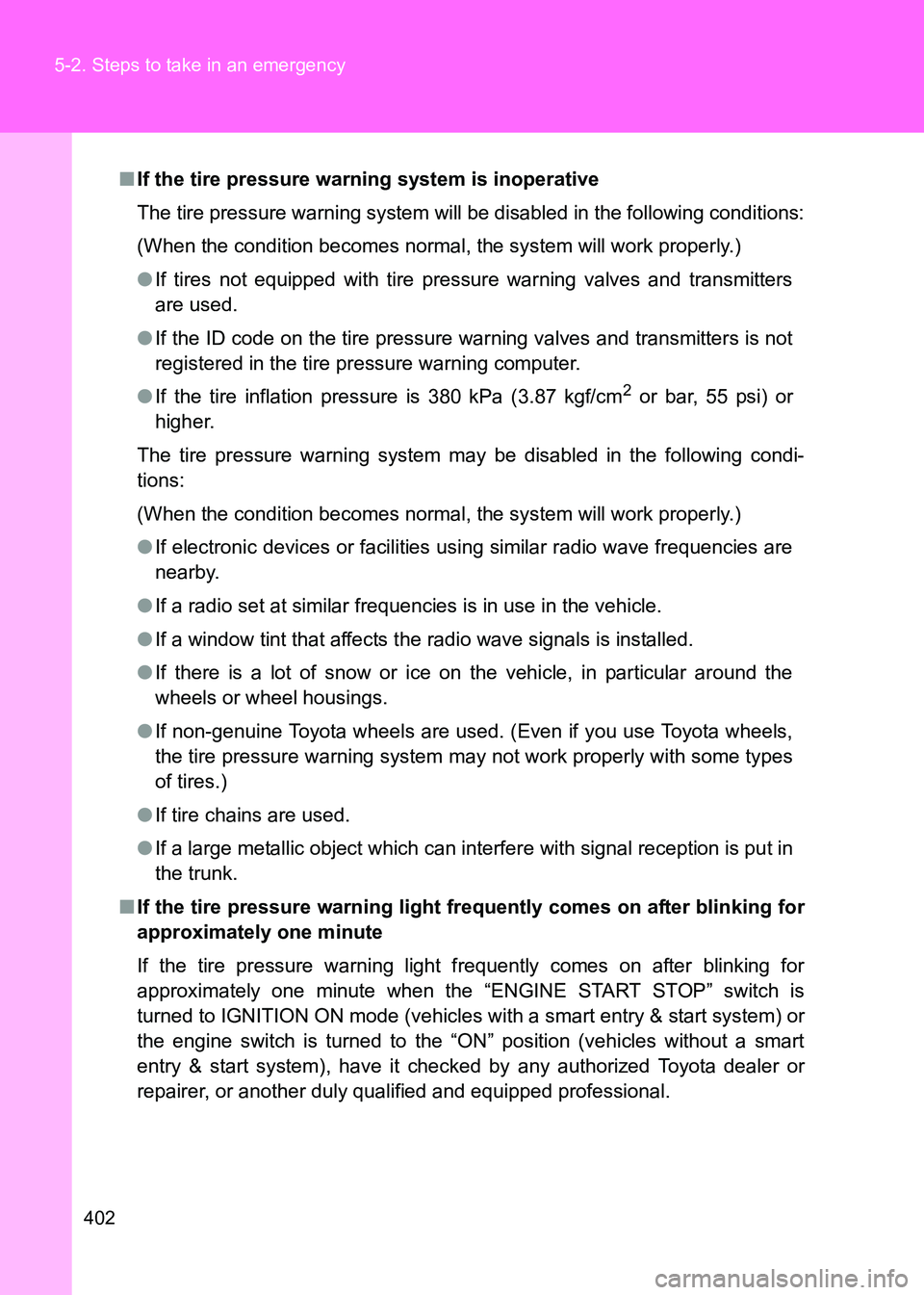Page 61 of 505

61
1-2. Opening, closing and locking the doors and trunk
1
Before driving
86_EE (OM18071E)
■
Trunk light
The trunk light turns on when the trunk is opened.
■ Function to prevent the trunk being locked with the electronic key
inside (vehicles with a smart entry & start system)
●When all doors are being locked, closing the trunk lid with the electronic
key left inside the trunk will sound an alarm.
In this case, the trunk lid can be opened using the entry function.
● Even when the spare electronic key is put in the trunk with all the doors
locked, the key confinement prevention function can be activated so the
trunk can be opened. In order to prevent theft, take all electronic keys
with you when leaving the vehicle.
● Even when the electronic key is put in the trunk with all the doors are
locked, the key may not be detected depending on the places and the
surrounding radio wave conditions. In this case, the key confinement pre-
vention function cannot be activated, causing the doors to lock when the
trunk is closed. Make sure to check where the key is before closing the
trunk.
● The key confinement prevention function cannot be activated if any one
of the doors is unlocked. In this case, open the trunk using the trunk
opener.
■ Using the mechanical key (vehicles with a smart entry & start system
but without the double locking system)
The trunk can be also opened using the mechanical key. ( →P. 455)
Page 132 of 505

132
1-7. Safety information
86_EE (OM18071E)
WARNING
■
Modification and disposal of SRS airbag system components
Do not dispose of your vehicle or perform any of the following modifications
without consulting any authorized Toyota dealer or repairer, or another duly
qualified and equipped professional.
The SRS airbags may malfunction or deploy (inflate) accidentally, causing
death or serious injury.
●Installation, removal, disassembly and repair of the SRS airbags.
● Repairs, modifications, removal or replacement of the steering wheel,
instrument panel, dashboard, seats or seat upholstery, front, side and rear
pillars or roof side rails.
● Repairs or modifications of the front fender, front bumper, or side of the
occupant compartment.
● Installation of a grille guard (bull bars, kangaroo bar, etc.), snow plows,
winches.
● Modifications to the vehicle's suspension system.
● Installation of electronic devices such as mobile two-way radios and CD
players.
● Installation of electronic devices such as an RF-transmitter and CD play-
ers.
● Modifications to your vehicle for a person with a physical disability.
Page 370 of 505
370
4-3. Do-it-yourself maintenance
86_EE (OM18071E)
■
Instrument panel
FuseAmpereCircuit
1ECU ACC 10 A Main body ECU, outside rear view
mirrors
2P/POINT No.2 15 A Power outlet
3PANEL 10 A Illumination
4TAIL 10 A Tail lights
5DRL 10 A Daytime running light system
6STOP 7.5 A Stop lights
7OBD 7.5 A On-board diagnosis system
8HEATER-S 7.5 A Air conditioning system
9HEATER 10 A Air conditioning system
10FR FOG LH 10 A Left-hand front fog light
11FR FOG RH 10 A Right-hand front fog light
12BK/UP LP 7.5 A Back-up lights
13ECU IG1 10 A ABS, electric power steering
14AM1 7.5 A Starting system
15AMP 15 A Audio system
16AT UNIT 15 A Transmission
17GAUGE 7.5 AGauge and meters, smart entry &
start system
18ECU IG2 10 A Engine control unit
19SEAT HTR LH 10 A Left-hand seat heater
20SEAT HTR RH 10 A Right-hand seat heater
21RADIO 7.5 A Audio system
22P/POINT No.1 15 A Power outlet
Page 402 of 505

402
5-2. Steps to take in an emergency
86_EE (OM18071E)
■
If the tire pressure warning system is inoperative
The tire pressure warning system will be disabled in the following conditions:
(When the condition becomes normal, the system will work properly.)
● If tires not equipped with tire pressure warning valves and transmitters
are used.
● If the ID code on the tire pressure warning valves and transmitters is not
registered in the tire pressure warning computer.
● If the tire inflation pressure is 380 kPa (3.87 kgf/cm
2 or bar, 55 psi) or
higher.
The tire pressure warning system may be disabled in the following condi-
tions:
(When the condition becomes normal, the system will work properly.)
● If electronic devices or facilities using similar radio wave frequencies are
nearby.
● If a radio set at similar frequencies is in use in the vehicle.
● If a window tint that affects t he radio wave signals is installed.
● If there is a lot of snow or ice on the vehicle, in particular around the
wheels or wheel housings.
● If non-genuine Toyota wheels are used. (Even if you use Toyota wheels,
the tire pressure warning system may not work properly with some types
of tires.)
● If tire chains are used.
● If a large metallic object which can interfere with signal reception is put in
the trunk.
■ If the tire pressure warning light frequently comes on after blinking for
approximately one minute
If the tire pressure warning light frequently comes on after blinking for
approximately one minute when the “ENGINE START STOP” switch is
turned to IGNITION ON mode (vehicles with a smart entry & start system) or
the engine switch is turned to the “ON” position (vehicles without a smart
entry & start system), have it checked by any authorized Toyota dealer or
repairer, or another duly qualified and equipped professional.